-

新人教版高中英语必修2Unit 3 The Internet-Discovering Useful Structure教案一
This unit is about the Internet, which has a great influence to our humans and our lives. During the Listening & Speaking & Talking and Reading and Thinking section, the influence in examples has been shown. Thus, use the Present Perfect Tense is appropriate. However, in order to show the justice or weaken the doer of the behavior/action, it’s better to use the Present Perfect Passive Voice than the Present Perfect Tense. Besides, having learned to use the Present Perfect Passive Voice, students can beautify their language in their writing. 1. Learn the structure of the Present Perfect Passive Voice and its functions. 2. Learn to change the sentences with the Present Perfect Passive Voice into the sentences with the Present Perfect Passive Voice. 3. Learn to write sentences with the Present Perfect Passive Voice flexibly according to the context. 1. Learn the structure of the Present Perfect Passive Voice and its functions. 2. Learn to change the sentences with the Present Perfect Passive Voice into the sentences with the Present Perfect Passive Voice. 3. Learn to write sentences with the Present Perfect Passive Voice flexibly according to the context. Step 1 Observe the following sentences, then change the sentences into passive voice.He has been selected to take part in the sports meeting.(肯定句)他已被挑选出来参加运动会。The ink has not been removed from his overcoat.(否定句)墨迹还没有从他外套上去掉。

新人教版高中英语必修2Unit 3 The Internet-Reading and Thinking教案二
Q5:What's Jan's next goal?Her next goal is to start a charity website to raise money for children in poor countries.Q6:What can we learn from her experiences?We learn that when we go through tough times, we can find help and support from other people online. We learn that we can feel less lonelyStep 5: While reading---rethinkingQ1: What is Jan’s attitude to the Internet ?Thankful/Grateful, because it has changed her and her life.Q2: What writing skills is used in the article ?Examples(Jan’s example, the 59-year-old man’s and the 61-year-old woman’s example)Q3: Can you get the main idea of the article ?The Internet has changed Jan’s life/Jan’s life has been changed by the Internet.Step 6 Post reading---Retell the storyMuch has been written about the wonders of the World Wide Web. There are countless articles (1)telling(tell) us how the Internet has made our lives more convenient. But the Internet has done a lot (2)more(much) for people than simply make life more convenient. People’s lives (3) have been changed(change) by online communities and social networks so far. Take Jan for example, who developed a serious illness that made her (4)stuck(stick) at home with only her computer to keep (5)her(she) company. She joined an online group (6)where she could share problems, support and advice with others. She considered the ability to remove the distance between people as one of the greatest (7)benefits(benefit). She was so inspired (8)that she started an IT club in which many people have been helped. She has started to learn more about how to use the Internet to make society better. Her next goal is to start a charity website to raise money (9)for children in poor countries. Jan’s life has been (10)greatly(great) improved by the Internet.

新人教版高中英语必修2Unit 4 History and Traditions-Listening&Speaking&Talking教案一
This unit is about history and traditions. From the opening page, we can know that this unit will introduce the history and traditions around the world. As Marcus Garvey says “A people without the knowledge of their past history, origin and culture is like a tree without roots”, it is important for students to realize the importance and value of knowing the history and traditions and their further meanings. And this part ( listening and speaking ) is divided into two parts: Part A---share views on historic sites, Part B ---talk about a visit to a historic tourist destination. By talking with a foreigner, the speakers introduce the historic attractions and their cultures. Part A is that William, a British student, who was going to visit the Confucius Temple and a Chinese student, Xiao Kong, who was going to the Confucius Temple to meet with the members of the research group, went together and exchanged their views on the Confucius Temple, Confucius, Confucius' descendants and Confucius' educational thoughts. Part B is a conversation between Xiao Yan, a youth hostel receptionist and Paul, a backpacker about the feelings and experience after visiting the Chinese famous tourist attraction Pingyao.1. Guide students to understand the content of listening texts in terms of the whole and key details; 2. Cultivate students' ability to guess the meaning of words in listening; discuss with their peers how to talk about historic spots and great person.3. Instruct students to use functional sentences of showing one’s excitement, surprise and disappointment.1. Guide students to understand the content of listening texts in terms of the whole and key details; 2. Cultivate students' ability to discuss with their peers the related topics.3. Enable students to use the functional items of showing one’s excitement, surprise and disappointment.

新人教版高中英语必修2Unit 4 History and Traditions-Discovering Useful Structure教案二
This teaching period mainly deals with grammar: The past participle is used as attributive and objective complement.1. Guide students to review the basic usages of the past participle used as attributive and objective complement.2. Lead students to learn to use some special cases concerning the past participle used as attributive and objective complement flexibly.3. Strengthen students’ great interest in grammar learning.1. Help students to appreciate the function of the past participle used as attributive and objective complement.2. Instruct students to write essays using the past participle used as attributive and objective complement.Step1:温故而知新。Analyze the underlined phrases and then sum up the common usages of the past participles.1.(教材P41)They had castles built(build) all around England, and made changes to the legal system.2.(教材P42)They use the same flag, known(know) as the Union Jack,...3.(教材P42)Judy and I had our car parked(park) in an underground car park near Trafalgar Square, where we could get our car battery charged(charge).Common points: f the past participle used as attributive and objective complement.Step 2:过去分词作定语时的意义1.及物动词的过去分词作定语,在语态上表示被动;在时间上,常表示动作已经发生或完成,有时也不表示时间性。Our teacher watched us doing the experiment and gave us a satisfied smile at last.我们的老师看着我们做实验,最后给了我们一个满意的微笑。The plan put forward at the meeting will be carried out soon.会上提出的计划将很快被执行。2.不及物动词的过去分词作定语,它不表示被动意义,只强调动作完成。Many little kids like gathering fallen leaves in the yard.

新人教版高中英语必修2Unit 4 History and Traditions-Reading and Thinking教案一
Features of languages1.Finally, in the 20th century, the southern part of Ireland broke away from the UK, which resulted in the full name we have today: the United Kingdom of Great Britain and Northern Ireland.该句是一个复合句。该句主句为:the southern part of Ireland broke away from the UK;which resulted in the full name we have today为which引导的定语从句代指前面整句话的内容,we have today为定语从句修饰先行词name。译文:最后,在20世纪,爱尔兰南部脱离英国,这导致了我们今天有的英国的全名:大不列颠及北爱尔兰联合王国。2.Almost everywhere you go in the UK, you will be surrounded by evidence of four different groups of people who took over at different times throughout history.该句是一个复合句。该句主句为:you will be surrounded by evidence of four different groups of people;其中Almost everywhere you go in the UK为让步状语从句; who took over at different times throughout history为定语从句修饰先行词people。译文:几乎无论你走到英国的任何地方,你都会发现历史上有四种不同的人在不同的时期统治过英国。3.The capital city London is a great place to start, as it is an ancient port city that has a history dating all the way back to Roman times.该句是一个复合句。该句主句为:The capital city London is a great place to start; as it is an ancient port city that has a history dating all the way back to Roman times.为原因状语从句;dating all the way back to Roman times为现在分词短语作定语修饰history。

新人教版高中英语必修2Unit 5 Music-Discovering Useful Structures教案二
4. When he got absorbed in his world of music, he felt as if he could “see” the beauty of the world around him, like he had in his previous life.P·P as adverbial: _________________________________________________________________.Function: _______________________________________________________________________.Step 5 Solid Complete the passage with the words in brackets in their correct forms.Well known as a successful band, the Impact members show quite a few striking qualities. They never ever give up. When _____________(question) by the media, they are not _____________(discourage) and practise even harder. They are improving themselves by attending several master training class. They are united. _____________(fill with) team spirit, they act as a whole, always aiming for glory. Step 6 Difference and similarity from -ingObserve the following examples.1. He went out, shutting the door behind him.=He went out, ________________________________________________________.2. Not knowing what to do, he went to his parents for help.=__________________________________________, he went to his parents for help.Similarity: _______________________________________________________________________________________________________________________________________________________.Difference : _______________________________________________________________________________________________________________________________________________________.Step Practice1. ________ in a hurry, this article was not so good. 因为写得匆忙, 这篇文章不是很好。2. ________ carefully, he found something he hadn’t known before. 他仔细读书时, 发现了一些从前不知道的东西。3. ________ why he did it, the monitor said it was his duty. 当被问及他为什么要这么做时, 班长说这是他的职责

新人教版高中英语必修2Unit 5 Music-Listening and Speaking教案
This lesson is about music. Students can classify the types of music through the instruments and its sound and can talk about their preferences about music, even join some activities and play a role in them according to their musical talents. On the basis, they are guided to use the languages to express their preferences and some plosive sounds and their rules.1. Classify the music types through the instruments and its sound.2. Listen and understand what the speakers’ preferences are and the reasons; talk about their own preferences and give their own reasons, using these sentences: “What kind of music do you like? And why? “ “Because it makes/gives me energy/peaceful.../touches my heart...”.3. Learn some plosives and the rules.4. Join some activities and play a role in them according to the talents. 1. Listen and understand what the speakers’ preferences are and the reasons;2. talk about their own preferences and give their own reasons, using these sentences: “What kind of music do you like? And why? “ “Because it makes/gives me energy/peaceful.../touches my heart...”.3. Learn some plosives and incomplete plosives and its rules.Step 1 Lead inPoint at the pictures on P50 and ask Q1: What are the people doing in the pictures below?Q2: What kind of music they are?Then play the MP3s one by oneStep 2 ListeningTask 1: A reporter from the school newspaper is interviewing students about music. Listen to the interviews. Draw lines between the words to make complete sentences. Some words will not be used.

新人教版高中英语必修2Unit 5 Music-Reading for Writing教案二
The Internet celebrity Gao Yifeng. Years ago, he owned 5 companies and the staffs over 1,000, but during the economy crisis, he became nothing but debt. He was so worried that his hair became white overnight. There was a time when he wanted to killed himself. But after listening to the song Start Over by Liu Huan, he decided to cheer himself up. He started a steamed bun shop and gradually became a national chain shops. Now he became successful again.Walter Haddon said, “Music is the medicine of a troubled mind.” Music contains such a pleasant and inspiring force. Music gave him courage and bravery. When he listened to the song, it made his spirit fly like a kite in the wind. Music gave him strength and brought him relief. It was the rock I leant on to become strong and to get through those hard times. I hope none of us have to go through the same kind of suffering that he did. At the same time, we all go through various periods when we feel sad or alone. During those times, music can help us in the same way that it helped him. I hope we all will somehow begin to treasure music and make it a part of our life. Thank you for your listening !5.Revise your writing each other.Does he/she explain how music has changed his/her/someone else’s life?Are some of the rhetorical devices included and used properly ?Does he/she talk about how music makes him/her/someone feel?Is the first word in each sentences capitalised?Does he/she use correct punctuation ?

新人教版高中英语选修3Unit 5 Poems教案
本单元阅读文本介绍了几种简单的英语诗歌形式,旨在让学生能理解和欣赏英语诗歌的美,包括形式美、内容美、意义美,培养审美情趣,并从作品的意义美中获得积极的人生态度和价值观念启示。 该文本是一则典型的说明性文本,用简单易懂的语言向英语诗歌的初学者们介绍了五种比较简单的英语诗歌形式。文题“A Few Simple Forms of English Poems”是整个文本的核心话题。正文内容共七段,按“总—分—总”建构。第一段为总起段,概述了英语诗歌的创作原因以及主要特点,涉及了形式、内容、意义等方面赏析英语诗歌的几个主要维度;第二段至第六段分别介绍了童谣、清单诗、五行诗、俳句和唐诗五种英语诗歌形式;第七段收尾,鼓励读者尝试英语诗歌创作。 在进行文本教学设计时,要引导学生梳理关于与诗歌要素和诗歌赏析有关的话题类语言,既包括format、rhythm、subject、image等名词,也包括have a strong rhythm、be made up of、contain、consist of、convey这样的动词和动词短语。

中班语言教案:趣味识动字—跳、爬、吹、打
2、激发幼儿学习兴趣,积极参与游戏活动。准备:多媒体课件(跳、爬、吹、打四个字);骰子一个;打、吹的物品;会爬动物的头饰(如虫、蜗牛);圈; 过程:一:看动画识字上次我们去动物园,看到了很多动物,还看到了海狮和大象为我们表演的节目,小朋友,觉得怎么样啊?有些小动物今天来到幼儿园,还要为我们表演节目,我们来看看它们是谁。 A:(1)图上是谁?它在干什么?我们来学学小公鸡吹喇叭吧!(2)小公鸡还带来一个字宝宝,认识一下吧,这是“吹”宝宝,请“吹”宝宝也表演一个节目。(3)还有什么东西也可以吹呢?是用什么吹的?“吹”宝宝的身上有什么?
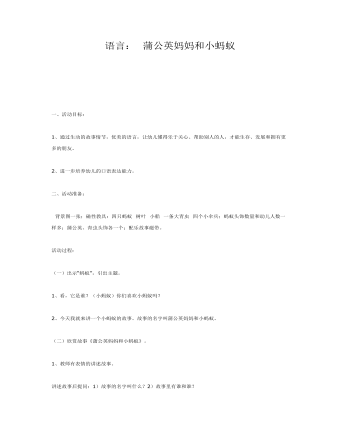
中班语言课件教案: 蒲公英妈妈和小蚂蚁
2、进一步培养幼儿的口语表达能力。二、活动准备: 背景图一张;磁性教具:四只蚂蚁 树叶 小船 一条大青虫 四个小伞兵;蚂蚁头饰数量和幼儿人数一样多;蒲公英、青虫头饰各一个;配乐故事磁带。活动过程:(一)出示“蚂蚁”,引出主题。1、看,它是谁?(小蚂蚁)你们喜欢小蚂蚁吗?2、今天我就来讲一个小蚂蚁的故事。故事的名字叫蒲公英妈妈和小蚂蚁。(二)欣赏故事《蒲公英妈妈和小蚂蚁》。1、教师有表情的讲述故事。讲述故事后提问:1)故事的名字叫什么?2)故事里有谁和谁?2、出示背景图,教师边演示教具边讲故事。讲述过程中提问:1)小河的对岸住着谁?2)一阵大风吹来,小蚂蚁坐的树叶小船怎么了?3)野地里有什么?它是什么样子的?4)蒲公英是怎样对待小蚂蚁的?5)小蚂蚁说了些什么?蒲公英妈妈又说了些什么?6)蒲公英妈妈为什么很感激小蚂蚁?7)小蚂蚁是怎样回到自己家的?8)这个故事告诉了我们一个什么道理?

中班语言课件教案:兔子先生去散步
第一环节,我以兔子的家为导入,看看猜猜,“这是谁的家啊?”让孩子在细致地观察中发现,培养阅读观察的能力。第二环节,是活动的重点,用看图猜谜的活动形式层层引入,根据故事中的标志联想故事的情节。当然在过程中谜底不是绝对的,例如眼泪的那段,也可以是雨滴、水滴、油滴,以引发孩子的讨论。在整个欣赏的过程中注重故事的完整性,在分段欣赏时,从故事开始到“小心坑洞”的那段,内容基本不变,后面的一段留一个疑问,“兔子先生掉到洞里后会碰到什么呢?”引起孩子完整欣赏故事的兴趣,在完整欣赏时了解答案。 第三环节,注重将文学作品回归到孩子的生活中。引导孩子交流讨论生活周围的图象与符号,自然引入社会认知的活动,活动有可持续发展的价值,如延伸活动“寻找生活中的标志、幼儿园、马路上的标志等等。
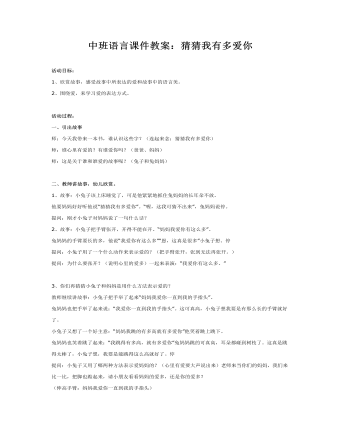
中班语言课件教案:猜猜我有多爱你
活动过程:一、引出故事师:今天我带来一本书,谁认识这些字?(连起来念:猜猜我有多爱你)师:谁心里有爱的?有谁爱你吗?(爸爸、妈妈)师:这是关于谁和谁爱的故事呢?(兔子和兔妈妈) 二、教师讲故事,幼儿欣赏。1、故事:小兔子该上床睡觉了,可是他紧紧地抓住兔妈妈的长耳朵不放。他要妈妈好好听他说“猜猜我有多爱你”。“喔,这我可猜不出来”,兔妈妈说停。提问:刚才小兔子对妈妈说了一句什么话?2、故事:小兔子把手臂张开,开得不能在开。“妈妈我爱你有这么多”。兔妈妈的手臂要长的多,他说“我爱你有这么多”“恩,这真是很多”小兔子想。停提问:小兔子用了一个什么动作来表示爱的?(把手臂张开,张到无法再张开。)提问:为什么要张开?(说明心里的爱多)一起来表演:“我爱你有这么多。”
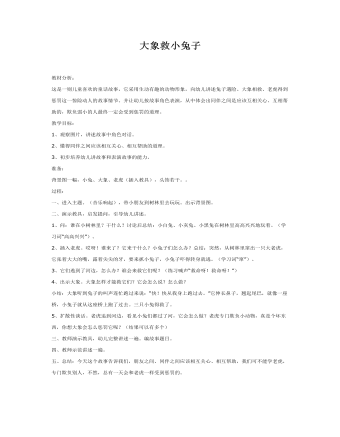
中班语言课件教案:大象救小兔子
教学目标: 1、观察图片,讲述故事中角色对话。 2、懂得同伴之间应该相互关心、相互帮助的道理。 3、初步培养幼儿讲故事和表演故事的能力。 准备: 背景图一幅,小兔、大象、老虎(插入教具),头饰若干。。 过程: 一、进入主题。(音乐响起),带小朋友到树林里去玩玩。出示背景图。 二、演示教具,启发提问,引导幼儿讲述。 1、问:谁在小树林里?干什么?讨论后总结:小白兔、小灰兔、小黑兔在树林里高高兴兴地玩着。(学习词“高高兴兴”)。 2、插入老虎。哎呀!谁来了?它来干什么?小兔子们怎么办?总结:突然,从树林里窜出一只大老虎,它张着大大的嘴,露着尖尖的牙,要来抓小兔子,小兔子吓得转身就逃。(学习词“窜”)。
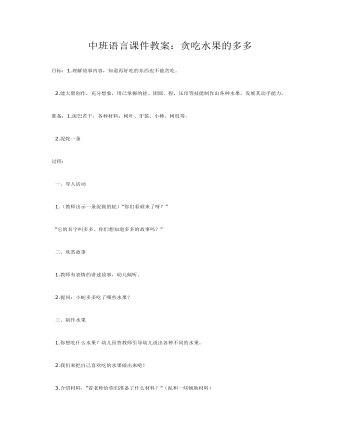
中班语言课件教案:贪吃水果的多多
2.能大胆创作,充分想象,用已掌握的搓、团圆、捏、压印等技能制作出各种水果,发展其动手能力。准备:1.泥巴若干,各种材料:树叶、牙签、小棒,树枝等。 2.泥蛇一条过程: 一、导入活动 1.(教师出示一条泥做的蛇)“你们看谁来了呀?” “它的名字叫多多。你们想知道多多的故事吗?” 二、欣赏故事 1.教师有表情的讲述故事,幼儿倾听。 2.提问:小蛇多多吃了哪些水果?
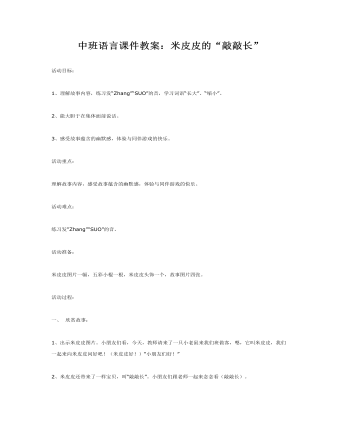
中班语言课件教案:米皮皮的“敲敲长”
2、能大胆于在集体面前说话。3、感受故事蕴含的幽默感,体验与同伴游戏的快乐。活动重点:理解故事内容,感受故事蕴含的幽默感,体验与同伴游戏的快乐。活动难点:练习发“Zhang”“SUO”的音。活动准备:米皮皮图片一幅,五彩小棍一根,米皮皮头饰一个,故事图片四张。活动过程:一、 欣赏故事:1、出示米皮皮图片。小朋友们看,今天,教师请来了一只小老鼠来我们班做客,嗯,它叫米皮皮,我们一起来向米皮皮问好吧!(米皮皮好!)“小朋友们好!”2、米皮皮还带来了一样宝贝,叫“敲敲长”。小朋友们跟老师一起来念念看(敲敲长)。3、米皮皮的敲敲长是一根五颜拥六色很漂亮的小棍,我们就叫它五彩小棍吧!“五彩小棍”我们一起说说看!
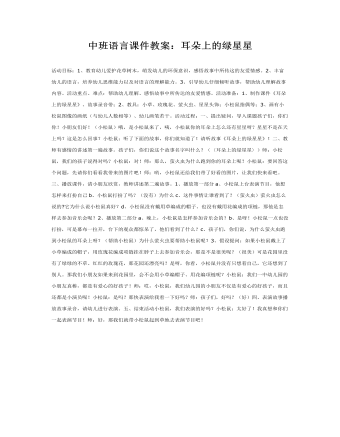
中班语言课件教案:耳朵上的绿星星
活动准备:1、制作课件《耳朵上的绿星星》、故事录音带;2、教具:小草、玫瑰花、萤火虫、星星头饰;小松鼠指偶等;3、画有小松鼠图像的画纸(与幼儿人数相等)、幼儿画笔若干。活动过程:一、提出疑问,导入课题孩子们,你们你!小朋友们好!(小松鼠)哦,是小松鼠来了,咦,小松鼠你的耳朵上怎么还有星星呀?星星不是在天上吗?这是怎么回事?小松鼠:听了下面的故事,你们就知道了!请听故事《耳朵上的绿星星》!二、教师有感情的讲述第一遍故事。孩子们,你们说这个故事名字叫什么?(〈耳朵上的绿星星〉)师:小松鼠,我们的孩子说得对吗?小松鼠:对!师:那么,萤火虫为什么跑到你的耳朵上呢?小松鼠:要回答这个问题,先请你们看看我带来的图片吧!师:哟,小松鼠还给我们带了好看的图片,让我们快来看吧。三、播放课件,请小朋友欣赏,教师讲述第二遍故事。1、播放第一部分a、小松鼠上台表演节目,他想怎样来打扮自己b、小松鼠打扮了吗?(没有)为什么c、这件事情让谁看到了?(萤火虫)萤火虫怎么说的?它为什么说小松鼠真好?d、小松鼠没有戴用草编成的帽子、也没有戴用花编成的项链,那他是怎样去参加音乐会呢?2、播放第二部分a、晚上,小松鼠是怎样参加音乐会的?b、是呀!小松鼠一点也没打扮,可是幕布一拉开,台下的观众都惊呆了,他们看到了什么?
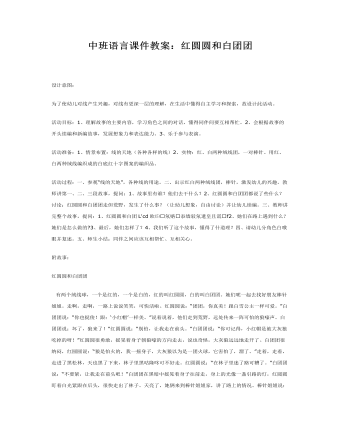
中班语言课件教案:红圆圆和白团团
活动准备:1、情景布置:线的天地(各种各样的线)2、实物:红、白两种绒线团,一对棒针。用红、白两种绒线编织成的白底红十字图案的编织品。活动过程:一、参观“线的天地”,各种线的用途。二、出示红白两种绒线团,棒针,激发幼儿的兴趣。教师讲第一、二、三段故事,提问:1、故事里有谁?他们去干什么?2、红圆圆和白团团都说了些什么?讨论:红圆圆和白团团走但荒野,发生了什么事?(让幼儿想象,自由讨论)并让幼儿续编。三、教师讲完整个故事,提问:1、红圆圆和白团L'cd欧⑸氖赂忝墙驳氖遣皇且谎f2、她们在路上遇到什么?她们是怎么做的?3、最后,她们怎样了?4、我们听了这个故事,懂得了什道理?四、请幼儿分角色白哦眼并复述。五、师生小结:同伴之间应该互相帮忙、互相关心。
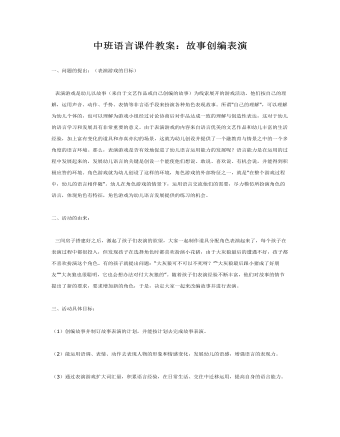
中班语言课件教案:故事创编表演
二、活动的由来: 三间房子搭建好之后,激起了孩子们表演的欲望,大家一起制作道具分配角色表演起来了,每个孩子在表演过程中都很投入,但发现孩子在选择角色时都喜欢扮演小花猪,由于大灰狼最后的遭遇不好,孩子都不喜欢扮演这个角色。有的孩子就提出问题:“大灰狼可不可以不死呀?”“大灰狼最后跟小猪成了好朋友”“大灰狼也很聪明,它也会想办法对付大灰狼的”。随着孩子们表演经验不断丰富,他们对故事的情节提出了新的要求,要求增加新的角色,于是,决定大家一起来改编故事并进行表演。三、活动具体目标:(1)创编故事并制订故事表演的计划,并能按计划去完成故事表演。(2)能运用语调、表情、动作去表现人物的形象和情感变化,发展幼儿的语感,增强语言的表现力。(3)通过表演游戏扩大词汇量,积累语言经验,在日常生活、交往中迁移运用,提高自身的语言能力。(4)培养幼儿自信、勇敢、大方的个性,能积极主动与人交谈、协商、合作与交往。

中班语言课件教案:恐龙妈妈藏蛋
2. 能看图讲述故事,体验编构故事结尾的乐趣。材料准备: 布置场景(草丛树洞沙滩鹅卵石泥土)图片挂图恐龙蛋若干指导要点: 1. 以玩藏蛋的游戏。体验藏的方法,知道怎样藏不被人发现。师“今天老师带来了几个东西。你们看看是什么?”(鸡蛋)“我们一块来玩藏蛋的游戏“一些小朋友来找蛋。”“你们要看那些地方藏蛋,不容易被发现? ”师提问:“你把蛋藏哪了?你为什么要这样藏?”2. 教师出示图一图二。引导幼儿围绕恐龙妈妈怎样藏蛋进行看图讲述。并引导幼儿大胆猜测恐龙妈妈藏蛋的办法。

